NC Permit test
1/99
There's no tags or description
Looks like no tags are added yet.
Name | Mastery | Learn | Test | Matching | Spaced |
|---|
No study sessions yet.
100 Terms
A driver’s license is required for which of the following?
I. Sitting in the driver’s seat of a car while the engine is running.
II. Steering a car while it is being pushed or towed by another vehicle.
A. I only
B. II only
C. Both I and II.
D. Neither I nor II
C
If a law enforcement officer swears that a driver has refused a legal chemical test, the Division of Motor Vehicles must
A. places the driver on probation
B. wait for a court decision before taking action
C. assign the driver to the Driver Improvement Clinic
D. revoke the driver’s license for at least 12 months.
D
Which of the following happen(s) under the point system?
I. A driver is sent a warning letter when he gets 4 points within 3 years.
II. A driver who gets 12 points within 3 years may lose his license.
A. I only
B. II only
C. Both I and II.
D. Neither I nor II
B
When a driver has a total of 7 points, which of the following may happen?
I. The driver can be required to file proof of financial responsibility.
II. The driver can have 3 points deducted if he satisfactorily completes a Driver Improvement Clinic.
A. I only
B. II only
C. Both I and II.
D. Neither I nor II
B
Conviction for which of the following carries the highest number of points?
A. reckless driving
B. hit and run with property damage
C. driving without a license
D. passing a stopped school bus unloading children
D
A driver will lose his license if he is convicted of
A. driving without a license
B. passing a stopped school bus
C. failing to yield the right of way
D. speeding more than 70 mph in a 55 mph zone
D
To get a revoked driver’s license restored, a person must do, which of the following?
I. obtain permission from the driver license section in Raleigh to reapply for a license.
II. Go to a driver license office, pay a restoration fee, and reapply for a license.
A. I only
B. II only
C. Both I and II.
D. Neither I nor II
C
Roughly half of all traffic fatalities involve, which of the following?
I. a drunken person.
II. More than one car.
A. I only
B. II only
C. Both I and II.
D. Neither I nor II
A
The percentage of highway deaths caused by drunken persons is about
A. 10%.
B. 25%.
C. 50%.
D. 67%.
C (Actually 38%)
Which of the following statements about pedestrian deaths is (are) correct?
I. in cities, two out of five people killed in motor vehicle accidents are pedestrians.
II. Most of the pedestrians killed in all traffic accidents are teenagers.
A. I only
B. II only
C. Both I and II.
D. Neither I nor II
A
When you are walking at night along the road, sidewalks, you should do, which of the following?
I. wear or carry something white
II. Keep your back to oncoming traffic.
A. I only
B. II only
C. Both I and II.
D. Neither I nor II
A
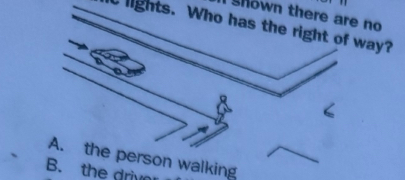
At the intersection shown there are no traffic lights. Who has the right of way?
A. the person walking.
B. the driver of the car.
C. No one.
D. whoever reaches the intersection first.
A
If you're walking along a road at night, what should you do?
I. walk on the right hand side with the traffic.
II. wear or carry something white.
A. I only
B. II only
C. Both I and II.
D. Neither I nor II
B
A safe driver does which of the following?
A. watches the side of the road over the hood to stay in lane.
B. frequently checks the rear view and side mirrors.
C. Drink coffee while driving at night to stay alert.
D. keeps two car lanes between his car and the next car on the expressway.
B
As you approach an intersection to make a right turn, you should turn on your car’s right turn signal, and do which of the following?
I. steer slightly toward the center of the road to give yourself room to clear the corner.
II. Hold your arm straight out the window.
A. I only
B. II only
C. Both I and II.
D. Neither I nor II
D
If you begin to feel sleepy, while driving on a long trip, you should do, which of the following?
I. Open a window or vent to let in fresh air.
II. Increase your speed.
A. I only
B. II only
C. Both I and II.
D. Neither I nor II
A
When driving on a long trip, you should
A. rest your eyes from time to time by rubbing them.
B. avoid looking at one thing for more than a few seconds.
C. Keep your eyes on the center of the road straight ahead.
D. spend as much time looking in your mirrors as you do looking in front of you.
B
In order to avoid being hit in the rear by another vehicle, you should do, which of the following?
I. Drive cautiously and use your break often.
II. Check your rearview mirrors often.
A. I only
B. II only
C. Both I and II.
D. Neither I nor II
B
Studies have shown, which of the following to be a serious traffic hazard?
I. middle-aged drivers.
II. Slow drivers.
A. I only
B. II only
C. Both I and II.
D. Neither I nor II
B
Very slow driving is especially dangerous in which of the following situations?
I. just after passing the crest of a hill.
II. Just after rounding a curve.
A. I only
B. II only
C. Both I and II.
D. Neither I nor II
C
Which of the following statements concerning speed limits on the open road in North Carolina is (are) correct?
I. unless otherwise posted, the speed limit for passenger cars and pick up trucks is 65 mph.
II. The speed limit for a school activity bus is 35 mph.
A. I only
B. II only
C. Both I and II.
D. Neither I nor II
D
Which of the following statements about speed limits for cars in North Carolina is (are) correct?
I. the speed limit outside the city is 55 mph unless otherwise posted.
II. The speed limit inside a city is 25 mph unless otherwise posted.
A. I only
B. II only
C. Both I and II.
D. Neither I nor II
A
Which of the following statements about speed limit in North Carolina is (are) correct?
I. unless otherwise posted, the speed limit inside a city is 35 mph.
II. Unless otherwise posted, the speed limit for school activity bus is 25 mph.
A. I only
B. II only
C. Both I and II.
D. Neither I nor II
A
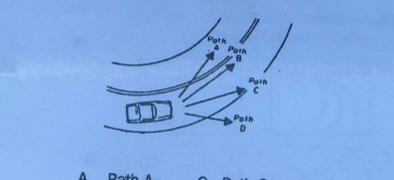
The car rounding the curve shown has a tendency to follow which path?
A. Path A
B. Path B
C. Path C
D. Path D
C
When rounding a curve, a car tends to
A. speed up
B. move to the inside of the curve
C. stay in the center of the lane
D. move to the outside of the curve
D
When rounding a sharp curve, you should do which of the following?
I. Stay as far to the left of your lane as possible.
II. Apply your brake in the sharpest part of the curve.
A. I only
B. II only
C. Both I and II.
D. Neither I nor II
D
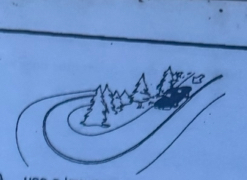
The driver of the car shown should
A. use a low gear when coming down the hill
B. pump his brake when he reaches the curve
C. apply the brake firmly and steadily going down the hill
D. speed up slightly on the curve to maintain control of the car
A
To reduce speed while going down a steep hill, you should do which of the following?
I. Use a lower gear.
II. Drive in a zigzag pattern.
A. I only
B. II only
C. Both I and II.
D. Neither I nor II
A
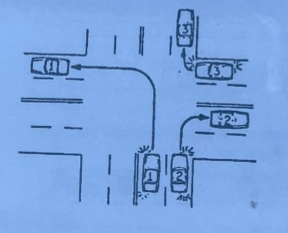
Which of the cars shown has made a correct turn?
A. car 1
B. car 2
C. Car 3
D. none of the cars
C
If you wish to pass the car ahead on a two-lane road, you should do which of the following?
I. Blow your horn to signal your intention to the driver of the cars ahead.
II. Give a left turn signal to let the driver behind you know your intention.
A. I only
B. II only
C. Both I and II.
D. Neither I nor II
C
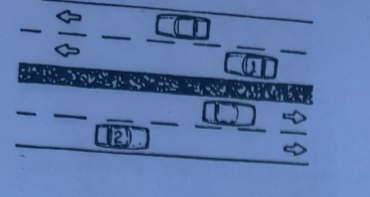
Which of the cars shown may pass?
A. car 1 only
B. car 2 only
C. both cars
D. neither car
C
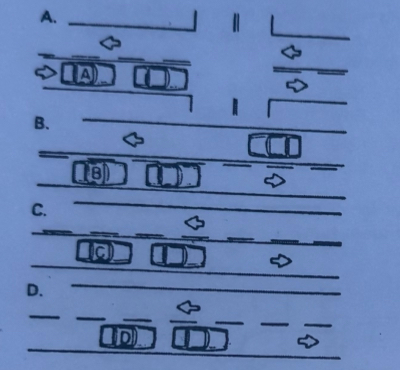
Which of the cars below can pass safely?
D
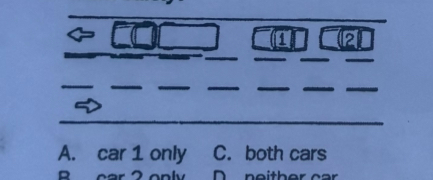
Which of the cars shown can pass the truck safely?
A. car 1 only
B. car 2 only
C. both cars
D. neither cars
D
Passing on the right is legal on which of the following?
I. A four-lane highway with 2 lanes going in each direction.
II. On a one-way street.
A. I only
B. II only
C. Both I and II.
D. Neither I nor II
C
When backing your car, you should do, which of the following?
I. move at no more than 10 mph.
II. Keep both hands on the steering wheel.
A. I only
B. II only
C. Both I and II.
D. Neither I nor II
A
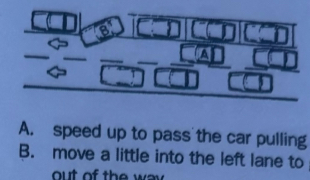
You are driving car A in heavy traffic. Up ahead you see car B just getting to leave its parking space. You should
A. speed up to pass the car pulling out.
B. move a little into the left lane to get out of the way.
C. Slow down and be prepared to stop.
D. blow your horn and keep going.
C
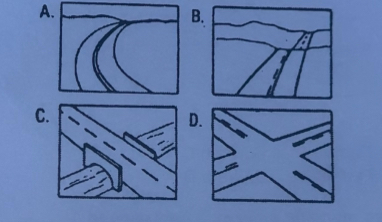
Accidents occur most frequently at which of the following?
D
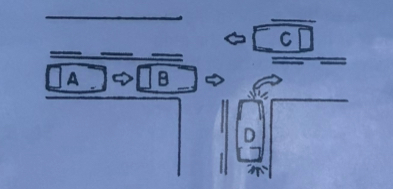
Which car shown must yield?
A. car A
B. car B
C. car C
D. car D
D
Highway accidents occur most frequently
A. on hills.
B. On curves.
C. At intersections.
D. at bridges.
C
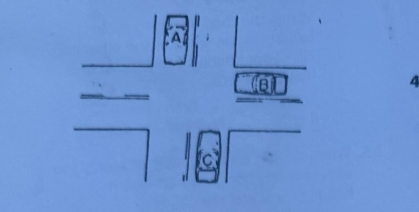
The intersection shown has no traffic lights or signs. In which order should the cars pass through the intersection?
A. car A, car B, car C
B. car B, car A, car C
C. car C, car A, car B
D. car B, car C, car A
A
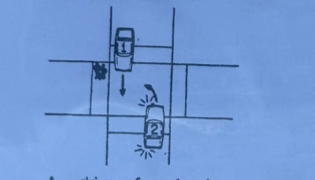
In the situation shown, the right-of way belongs to the
A. driver of car 1 only
B. driver of car 2 only
C. pedestrians only
D. driver of car 1 and the pedestrians
D

The intersection shown has no traffic lights or signs. The law gives the right of way to
A. car A only
B. car A and then car B
C. car B and then car A
D. car B
D
If you come to an unmarked intersection where it is hard to see in all directions because of trees or buildings, you should
A. Drive at the posted speed limit.
B. stop near the center of the intersection and continue if it is safe.
C. Slow down and blow your horn to warn drivers who cannot see you.
D. stop at the intersection and move forward slowly.
D
When driving on a city street, you should watch out for which of the following?
I. traffic coming from side streets.
II. Animals or small children from between parked cars.
A. I only
B. II only
C. Both I and II.
D. Neither I nor II
C
When driving in heavy traffic, you should do which of the following?
I. Watch out for drivers who make quick stops.
II. Yield to pedestrians only at marked crosswalks.
A. I only
B. II only
C. Both I and II.
D. Neither I nor II
A
If you're in the wrong lane for making a left turn at an intersection, you should
A. go to the next intersection and turn there.
B. back up and move into the correct lane for turning.
C. Wait until all other cars have cleared the intersection and turn.
D. Signal the driver in the car beside you that you intended turn in front of him.
A
The most frequent type of accident on interstate highways is
A. sideswipe collision.
B. running off the road.
C. Rear end collision.
D. head-on collision.
C
When taking a long trip on an interstate highway, you should plan on doing which of the following?
I. stopping 100 miles at a rest area.
II. Scheduling some hours of night driving to avoid heavy traffic.
A. I only
B. II only
C. Both I and II.
D. Neither I nor II
A
You were driving on an interstate highway when a break down forces you to the shoulder. You should
A. sit in the car until help arrives.
B. tie a handkerchief to the left door handle and stand beside the left front fender
C. Raise the hood and tie a white handkerchief to the left door handle.
D. raise the hood and stand behind the car to drivers of oncoming cars can see you.
C
Studies have shown that under normal conditions the chance of a car being involved in an accident on an interstate highway is greater if the driver
A. maintains the steady speed.
B. travels considerably below the posted speed limit.
C. Travels at the posted speed limit.
D. maintains his positions relative to cars in front and behind him in his lane.
B
If you miss your exit on an interstate highway, you should do, which of the following?
I. make a U-turn.
II. Go onto the next exit.
A. I only
B. II only
C. Both I and II.
D. Neither I nor II
B
A driver may be temporarily blinded at night by which of the following?
I. glare from the headlights of other cars.
II. Flame from a match he strikes to light a cigarette.
A. I only
B. II only
C. Both I and II.
D. Neither I nor II
C
In which of the following situations should you use low beams?
I. at night in the city.
II. In foggy or misty weather.
A. I only
B. II only
C. Both I and II.
D. Neither I nor II
C
If the driver of an approaching car fails to dim his headlights, you should do, which of the following?
I. Watch the road ahead to avoid looking at the lights of the other car.
II. Flock your headlight beams up and down one time
A. I only
B. II only
C. Both I and II.
D. Neither I nor II
C
When driving on a highway at night, you should never use your high-beam headlights if you are
A. slowing down for a turn.
B. traveling on a road with no median.
C. Going down a hill.
D. following another car.
D
If it starts to drizzle while you are driving, you should do which of the following?
I. slow down because the rain will loosen oil and gravel on the road.
II. Allow at least twice the normal following distance.
A. I only
B. II only
C. Both I and II.
D. Neither I nor II
C
Roads are likely to be especially slick
A. just after they have been paved
B. Just after it has begun to rain or drizzle.
C. After it has been raining for several hours.
D. in exceptionally cold, dry weather.
B
When driving through heavy fog, you should
A. turn on your bright lights.
B. slow down.
C. Follow the car in front of you closely.
D. turn on your parking lights.
B
When driving in a heavy snowstorm during the day, you should use
A. parking lights.
B. low beam headlights.
C. Four-way flashers.
D. High beam headlights.
B
The best way to get good traction on hard packed snow is to
A. put chains on your tires.
B. use snow tires.
C. Have lower than usual air pressure in your tires.
D. Carry heavy weights in your trunk.
A
When trying to pull away from a slippery surface in a car with a manual shift, you should do which of the following?
I. start in second or high gear.
II. Accelerate rapidly.
A. I only
B. II only
C. Both I and II.
D. Neither I nor II
A
When pulling a trailer down a long steep hill, you should do which of the following?
I. Drive in a lower gear.
II. Keep in the right lane.
A. I only
B. II only
C. Both I and II.
D. Neither I nor II
C
If your brakes fail, you should do, which of the following?
I. shift into a lower gear.
II. Use the emergency brake.
A. I only
B. II only
C. Both I and II.
D. Neither I nor II
C
Wet brakes can be dried out by doing which of the following?
I. turning on the heater.
II. Shifting into a lower gear and keeping light pressure on the brake pedal.
A. I only
B. II only
C. Both I and II.
D. Neither I nor II
B
If you have a blowout while traveling at a high speed, you should do which of the following?
I. apply the break firmly as soon as you notice the blowout.
II. Grip the steering wheel firmly to keep the car from swerving.
A. I only
B. II only
C. Both I and II.
D. Neither I nor II
B
When changing a flat tire, you should do, which of the following?
I. put the vehicle in neutral gear.
II. Block the wheels.
A. I only
B. II only
C. Both I and II.
D. Neither I nor II
B
If your car breaks down on the highway at night, what should you do?
I. Park the car completely off the road.
II. Turn off the high beam lights.
A. I only
B. II only
C. Both I and II.
D. Neither I nor II
A
If your car breaks down on a highway at night, you should do which of the following?
I. raise the hood and entire white handkerchief to the left door handle.
II. Switch on the parking lights.
A. I only
B. II only
C. Both I and II.
D. Neither I nor II
C
If your vehicle has run off the road onto the shoulder, you should
A. shift quickly to a lower gear.
B. brake with heavy constant pressure
C. Apply the emergency brake.
D. take your foot off the gas pedal gradually.
D
Skids are likely to occur on which of the following roads?
I. One on which snow has become packed.
II. One that has just been paved.
A. I only
B. II only
C. Both I and II.
D. Neither I nor II
A
If you have to come to a stop on an icy road, you should
A. use your hand brake
B. put the brake on hard.
C. Apply the brake in short hard jabs.
D. pump the brake pedal lightly.
D
What should you do when you begin to skid?
I. turn the steering wheel in the direction in which the rear end of the car is skidding.
II. Reduce pressure on the gas pedal.
A. I only
B. II only
C. Both I and II.
D. Neither I nor II
C
A driver who is involved in an accident should do which of the following?
I. make an immediate report to the nearest law-enforcement agency.
II. notify his insurance company.
A. I only
B. II only
C. Both I and II.
D. Neither I nor II
C
A flashing red traffic signal at an intersection means which of the following
I. slow down and proceed with caution.
II. Stop only if it is necessary to yield the right of way.
A. I only
B. II only
C. Both I and II.
D. Neither I nor II
D
A flashing yellow traffic signal at an intersection means
A. not right turn
B. yield the right of way.
C. No left turn.
D. slow down and proceed with caution.
D
A diamond shaped sign would be used to warn drivers of which of the following driving hazards?
I. a railroad crossing.
II. A deer crossing.
A. I only
B. II only
C. Both I and II.
D. Neither I nor II
B
A diamond shaped traffic sign means
A. no left turn.
B. come to a full stop.
C. yield the right of way.
D. slow down and drive with care.
D
When can you disregard a signal given by a police officer directing traffic?
I. an emergency vehicle is approaching.
II. The officers signal is in conflict with a traffic signal.
A. I only
B. II only
C. Both I and II.
D. Neither I nor II
D
What is the main color for signs in highway work zones?
A. red.
B. white.
C. Orange.
D. green.
C
When does the law give a blind pedestrian special consideration at intersections where there are no traffic lights?
I. only when he's alone.
II. If he holds out a white cane or has a guide dog with him.
A. I only
B. II only
C. Both I and II.
D. Neither I nor II
B
Which of the following statements about bicycle riders is (are) correct?
I. they must ride their bicycles facing traffic.
II. They are likely to be seriously injured in almost any collision with a car.
A. I only
B. II only
C. Both I and II.
D. Neither I nor II
B
In North Carolina, which of the following are required on all cars?
A. license plate lights.
B. courtesy lights.
C. Fender lights.
D. back up lights.
A
Your brakes need checking if
A. there is a strong smell of gasoline in the car.
B. the engine stalls at stoplight.
C. light gusts of wind make the car difficult to control.
D. there's a squeaking noise when you step on the brake.
D
Which of the following statements about horns and sirens is (are) correct?
I. every licensed motor vehicle must have a horn.
II. Only law-enforcement and emergency vehicles may have a siren.
A. I only
B. II only
C. Both I and II.
D. Neither I nor II
C
A motor vehicle must be equipped with
A. a muffler.
B. 4 ply tires.
C. Mud guards.
D. shoulder harnesses.
A
The system that carries harmful fumes from the engine to the rear of the car and releases them is called the
A. ignition system.
B. fuel system.
C. Suspension.
D. exhaust system.
D
A leaky exhaust system should be repaired because it
A. wastes gas and oil.
B. causes the engine to run hot.
C. May allow dangerous fumes to enter the car.
D. makes the engine hard to start and likely to stall.
C
A car that pitches and tosses in normal driving and leans heavily to the side in turns is likely to have trouble in which of the following systems?
A. ignition.
B. steering.
C. brake.
D. suspension.
D
Which traffic is required to stop if a school bus makes a passenger stop in the far right lane on a five lane street?
A. all lanes of traffic.
B. lanes going in the same direction as the school bus.
C. Lanes going in opposite direction of bus.
D. turning lane only.
B
Maximum speed limit for a full-size public school bus in North Carolina is:
A. 55 mph.
B. 45 mph.
C. 35 mph.
D. 25 mph.
B
Kinetic energy is:
A. Electric energy.
B. Energy from the sun.
C. Energy at rest.
D. Energy of motion.
D
What type of automobile insurance is required by law?
A. comprehensive.
B. liability.
C. Collision.
D. medical payments.
B
It is more difficult to stop a vehicle going downhill because of
A. gravity.
B. inertia.
C. Friction.
D. momentum.
A
“Dram Shop” refers to:
A. place where alcohol is sold
B. responsibility of seller of alcohol for actions of others.
C. A store where drams are sold.
D. highway patrols set up roadblocks.
B
Which of the following is (are) true of a clover leaf intersection?
I. it is an intersection at which a bridge carries one road over the other.
II. At a clover leaf, all turns are left turns.
A. I only
B. II only
C. Both I and II.
D. Neither I nor II
A
Of the following affect insurance premiums “EXCEPT”:
A. driving experience.
B. type of vehicle.
C. Sex of driver.
D. distance the car is driven to and from work.
C
The minimum requirement for liability insurance in North Carolina is
A. 5-10-5
B. 50-100-50
C. 30-60-25
D. 100-30-100
C
Coolant level is related directly to:
A. the radiator.
B. the transmission.
C. The air conditioner.
D the tires
A
A deductible cause refers to:
A. no fault insurance
B. the transmission.
C. The air conditioner.
D. the tires.
B
Damage to a vehicle caused by lightning would be covered by:
A. property damage liability.
B. comprehensive.
C. Collision.
D. towing insurance.
B